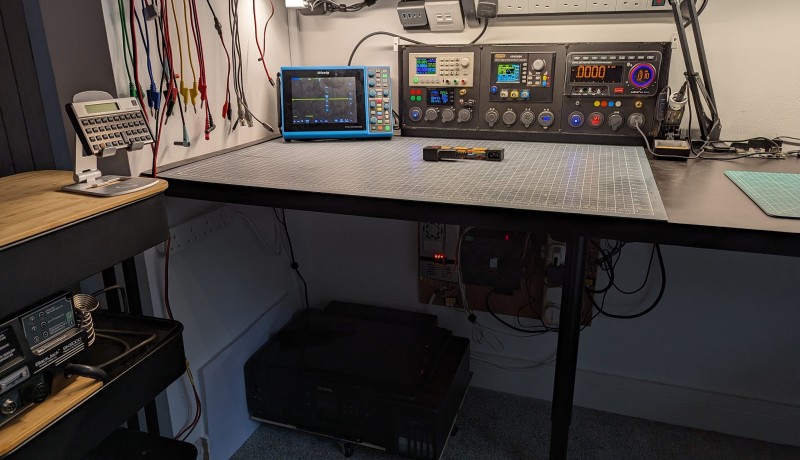Behind the Electronics Projects: Uncovering the Workspace of John Hind

Come and explore the workshop of John Hind, a retiree from Gunnislake, UK, who has a side-hustle of maintaining ancient CNC weaving looms. Learn how he cleverly combines electronics with crafting, organizes his compact space, repurposes tools, and takes on exciting electronics projects. John's passion is sure to inspire you.
How would you best describe your space?
John Hind: Compact electronics workbench with essential test equipment to hand.
How long have you been using your workspace, and how frequently do you engage with your electronics-related projects within it?
John: I've noticed that test equipment tends to take up a lot of bench space, particularly depth, crowding projects into a too-small gap at the front. I wanted all the essential equipment to be instantly available but take up as little valuable bench space as possible.
What are your technical interests?
John: Microcontrollers for home automation and machines for crafters (looms, 3D printers, laser cutters, vinyl cutters etc.)
Do you enjoy learning about where other engineers and makers work on electronics projects? Take a look at these electronics workspaces.
What sort of equipment and tools do you have in your space? Can you tell us how and where you store the equipment and tools?
John: The rear panel contains a 60 V 6A variable DC power supply, a mains power monitor, a signal generator and a digital multimeter (randomly combined with a Bluetooth speaker!). It also supplies an assortment of 12 V DC and USB power outlets fed from an ATX power supply under the bench. I repurposed car/boat components for this. I also have a couple of IKEA trollies (one to the left) for more rarely used kit such as hot air soldering and oscilloscope.
What do you consider to be your most important or valued piece of equipment or tool and why?
John: Replica HP15C calculator (on the trolly to the left), launched in 1982 and never bettered for electronics work (except the replica is much faster!).
Is there anything special or unique about your space?
John: I decided to buy all shallow panel mounting equipment, with bulky items like power supplies separate and relocated under the bench. The DMM is the only exception: this was modified from a bench unit by dremeling the main circuit board and front panel away from the rear part with the PSU and (random, but surprisingly good) Bluetooth Speaker, which I moved below the bench. The three flat panels use a 3D-printed chassis glued to a laser cut acrylic front panel. Mains power control uses latching relays under the bench controlled by low voltage push buttons (three of the relay assemblies are being tested on the bench). These underutilized components use no power except for a brief pulse to change state.
Are you planning anything new for your space?
John: It is done for now!
John: Raspberry Pi-based 3D Printer Controller enabling remote operation of printer in the shed using a wired Ethernet connection. All user interfaces using Web technologies and Docker Containerisation. Sensors connected to Pi using I2C bus and programmed in Circuit Python.
Are you currently working on electronics projects or a programming project?
John: Building my own computer components. Recently completed an ortholinear 12×4 keyboard with my own layout design coded in Python. Designing a built from materials computer enclosure designed in CAD on a perfect cube layout with all wiring fully enclosed.
Do you have a dream project or something you'd love to tackle?
John: I'd really like to take the HP15C calculator design into the new millennium with a larger, fully graphical display. Still looking for a letterbox format, monochrome, high-resolution LCD as I am determined not to lose the advantage of low power. To fit in the iconic design of the HP Voyager series (which includes the 15C) the display needs to be about 120 mm wide by 20 mm high. So far, no luck sourcing such a thing, so the project is either on hold or will have to be virtual only!
Do you have any advice, tips, or encouragement for other engineers or makers who are thinking of putting together a workspace?
John: With all the online shops, including direct from China, lots of great new equipment is available at good prices. Think about repurposing stuff like using automotive components and IKEA kitchen trollies. Test equipment on trollies is a great idea to avoid cluttering small benches! Always leave room to actually make something!
Show off Your Electronics Workspace!
Would you like to share details about your workspace with Elektor’s global community of engineers, students, and makers? Take a few minutes to fill out this form so our editors can get in touch with you!
